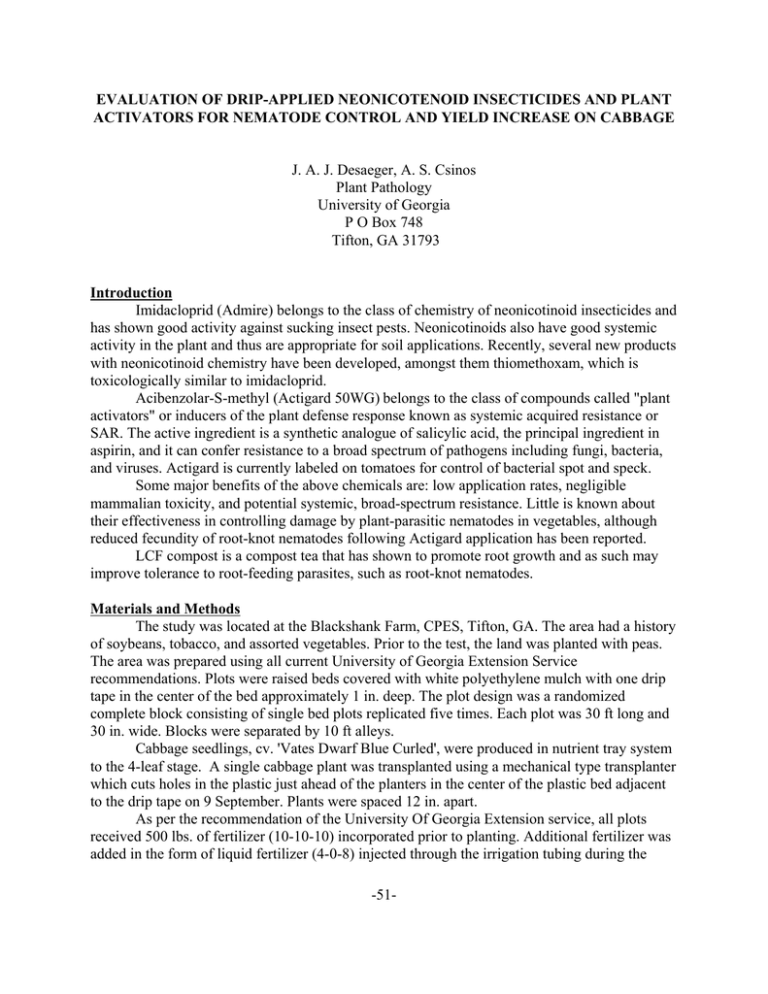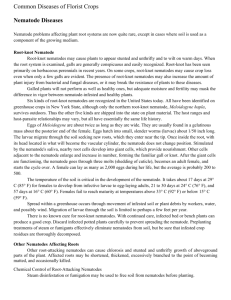EVALUATION OF DRIP-APPLIED NEONICOTENOID INSECTICIDES AND PLANT
advertisement

EVALUATION OF DRIP-APPLIED NEONICOTENOID INSECTICIDES AND PLANT ACTIVATORS FOR NEMATODE CONTROL AND YIELD INCREASE ON CABBAGE J. A. J. Desaeger, A. S. Csinos Plant Pathology University of Georgia P O Box 748 Tifton, GA 31793 Introduction Imidacloprid (Admire) belongs to the class of chemistry of neonicotinoid insecticides and has shown good activity against sucking insect pests. Neonicotinoids also have good systemic activity in the plant and thus are appropriate for soil applications. Recently, several new products with neonicotinoid chemistry have been developed, amongst them thiomethoxam, which is toxicologically similar to imidacloprid. Acibenzolar-S-methyl (Actigard 50WG) belongs to the class of compounds called "plant activators" or inducers of the plant defense response known as systemic acquired resistance or SAR. The active ingredient is a synthetic analogue of salicylic acid, the principal ingredient in aspirin, and it can confer resistance to a broad spectrum of pathogens including fungi, bacteria, and viruses. Actigard is currently labeled on tomatoes for control of bacterial spot and speck. Some major benefits of the above chemicals are: low application rates, negligible mammalian toxicity, and potential systemic, broad-spectrum resistance. Little is known about their effectiveness in controlling damage by plant-parasitic nematodes in vegetables, although reduced fecundity of root-knot nematodes following Actigard application has been reported. LCF compost is a compost tea that has shown to promote root growth and as such may improve tolerance to root-feeding parasites, such as root-knot nematodes. Materials and Methods The study was located at the Blackshank Farm, CPES, Tifton, GA. The area had a history of soybeans, tobacco, and assorted vegetables. Prior to the test, the land was planted with peas. The area was prepared using all current University of Georgia Extension Service recommendations. Plots were raised beds covered with white polyethylene mulch with one drip tape in the center of the bed approximately 1 in. deep. The plot design was a randomized complete block consisting of single bed plots replicated five times. Each plot was 30 ft long and 30 in. wide. Blocks were separated by 10 ft alleys. Cabbage seedlings, cv. 'Vates Dwarf Blue Curled', were produced in nutrient tray system to the 4-leaf stage. A single cabbage plant was transplanted using a mechanical type transplanter which cuts holes in the plastic just ahead of the planters in the center of the plastic bed adjacent to the drip tape on 9 September. Plants were spaced 12 in. apart. As per the recommendation of the University Of Georgia Extension service, all plots received 500 lbs. of fertilizer (10-10-10) incorporated prior to planting. Additional fertilizer was added in the form of liquid fertilizer (4-0-8) injected through the irrigation tubing during the -51- growing season. All plots were sprayed with Manex with Zinc (2.4 qt/A) plus Kocide LF (0.5 gal/A) and Bravo (2 pts/A) for control of foliar diseases, and Ambush (10 oz./A) alternating with Pounce 3.2 (6 oz./A), Asana XL (6 oz./A) and Avaunt (3 oz./A) for insect control. All treatments were applied through the drip system immediately after planting on 10 September. Applications were done over a 1 hr irrigation period (Table 1). Actigard was also applied at 3 and 6 weeks after planting, whereas LCF Compost was also applied at 4 and 7 weeks after planting. Stand counts were made to record live plants on 13, 15 and 22 September. Plant vigor ratings were done on 29 September and 10 October. The plots were rated on a 1 to 10 scale, 10 representing live and healthy plants and 1 representing dead plants. Nematode soil samples were collected at plant and at final harvest. They consisted of twelve cores of soil, 2.5-cm-diam. × 25-cm-deep. Nematodes were extracted from a 150-cm3 soil sub-sample using a centrifugal sugar flotation technique. Root evaluations were done at 7 weeks after planting (WAP) on three plants per plot, and again following final harvest on the remaining plants. Evaluations were done by staining a randomly selected 5 g subsample and counting the number of egg masses. Shoot and root fresh weights were recorded on 27 October (three plants per plot). Cabbage heads were hand-harvested on 25 November. Heads were harvested from the 20 middle plants and separated into different sizes (less than 6 in. diameter, and $ 6 in. diameter), counted, and weighed. All data collected was analyzed with an analysis of variance (P = 0.05) and means were separated using Duncan's Multiple range test. Summary Both nicotenoid insecticides (imidacloprid and thiomethoxam) appeared to stimulate reproduction of root-knot nematode and resulted in greater root-knot nematode soil populations than the Nemacur, LCF compost and Actigard treatments (Table 2). However, overall nematode pressure was low. No significant differences were observed with regard to early cabbage growth. Cabbage yields were excellent throughout the test and did not show significant differences among treatments (Table 1). Acknowledgements The authors wish to thank Jimmy Laska, Chris Williamson, Tonya Jo Cravens, Unessee Hargett, Lewis Mullis and Don Hickey for technical support. -52- Table 1. Growth and yield of cabbage as affected by different drip applications, Fall 2003, Black Shank Farm Tifton, GA. Plant vigor (1-10) Shoot wgt (lbs) Root wgt (g) Marketable heads Weight No. (lbs) 15.4 74.6 Small heads Treatment Imidacloprid (Admire 240 FC) Imidacloprid (Admire 240FC) Thiomethoxam 2F Appl. rate /A 0.197 lbs a.i. 2 WAP 8.4 4 WAP 8.6 7 WAP 3.11 ab 7 WAP 44.4 ab Harvest 49.8 0.310 lbs a.i 8.4 8.6 3.91 a 55.8 a 55.3 16 68.4 5 0.125 lbs a.i. 8.2 8.6 2.92 ab 44.2 ab 51.1 17.8 76.3 3 Acibenzolar-Smethyl (Actigard) LCF compost 1 oz. a.i. a 9.0 9.4 3.20 ab 48.0 ab 47.5 17.6 78.3 2.2 2 qts a 8.0 8.4 2.80 b 43.2 ab 56.0 14.8 61.9 4.4 6.0 a.i 8.0 8.4 3.04 ab 48.6 ab 54.5 15.2 72.1 5.6 6.0 a.i + 2 qts a 7.2 7.8 2.94 ab 46.2 ab 55.0 15.2 65.1 4.4 7.8 8.0 3.03 ab 40.5 b 51.9 16.2 75.7 3.4 Nemacur Nemacur + LCF compost Non-treated No. 4.6 WAP = weeks after planting; All chemicals were applied through the drip immediately after planting over a 1 hr irrigation period; a Applications of Actigard and LCF compost were also done at 3-4 (second application) and 6-7 WAP (third application) Plant vigor was rated on a 1-10 scale with 1= dead plants and 10= live and healthy plants. Marketable heads were heads $6 in. diameter; small heads were < 6 in diameter. Data are means of five replications. Means followed by the same letter are not significantly different (P = 0.05) according to Duncan’s multiple range test. -53- Table 2. Root-knot nematode infection and nematode soil populations with cabbage as affected by different at-plant drip applications, Fall 2003, Black Shank Farm Tifton, GA. Nematode root infection No. eggmasses/5 g No. root galls/5 g root Nematode soil populations (150 cc soil) Treatment Imidacloprid (Admire 240 FC) Imidacloprid (Admire 240FC) Thiomethoxam 2F Appl. rate /A 0.197 lbs a.i. 7 WAP 12 ab 11 WAP 9 abc 11 WAP 15 bc Root-knot 30 abc Stubby root 136 Non parasitic 528 0.310 lbs a.i 40 ab 12 a 33 a 52 a 150 694 0.125 lbs a.i. 46 a 11 ab 35 a 37 ab 142 536 Acibenzolar-S-methyl (Actigard) LCF compost Nemacur Nemacur + LCF compost Non-treated 1 oz. a.i. a 15 ab 4 bcd 10 bc 8d 108 576 2 qts a 6.0 a.i 6.0 a.i + 2 qts a 16 ab 5b 7b 2 cd 1 cd 0d 7 bc 2c 0c 4 cd 9 cd 4d 124 105 108 468 374 408 21 ab 4 bcd 19 ab 10 cbd 124 542 All chemicals were applied through the drip system at planting over 1 hr; WAP = weeks after planting a Applications of Actigard and LCF compost were also done at 3-4 (second application) and 6-7 WAP (third application) At plant nematode soil populations were on average 6 root-knot nematodes, 13 stubby root nematodes and 830 non-parasitic nematodes per 150 cc soil; Root-knot nematode = Meloidogyne incognita; Stubby root nematode = Paratrichodorus spp.; Non-parasitic = bacterial-feeding, fungal-feeding and predatory nematodes. Data are means of five replications. Means followed by the same letter are not significantly different (P = 0.05) according to Duncan’s multiple range test. -54-




